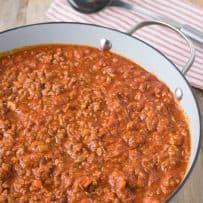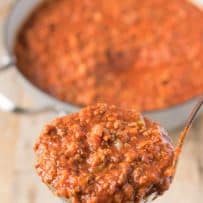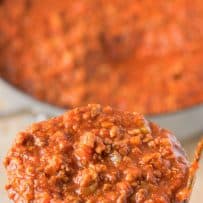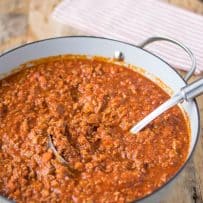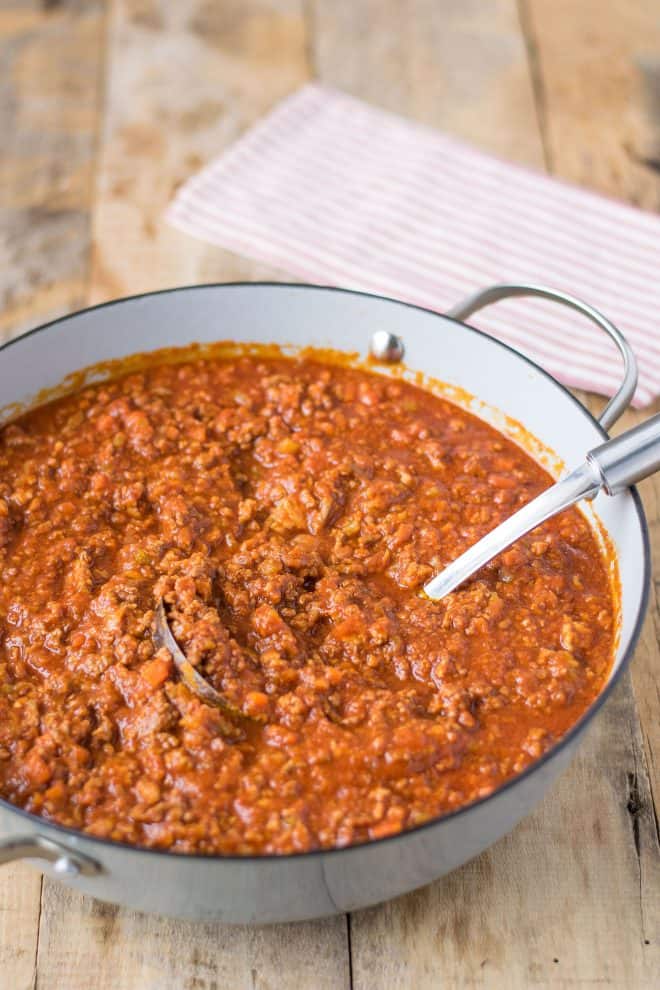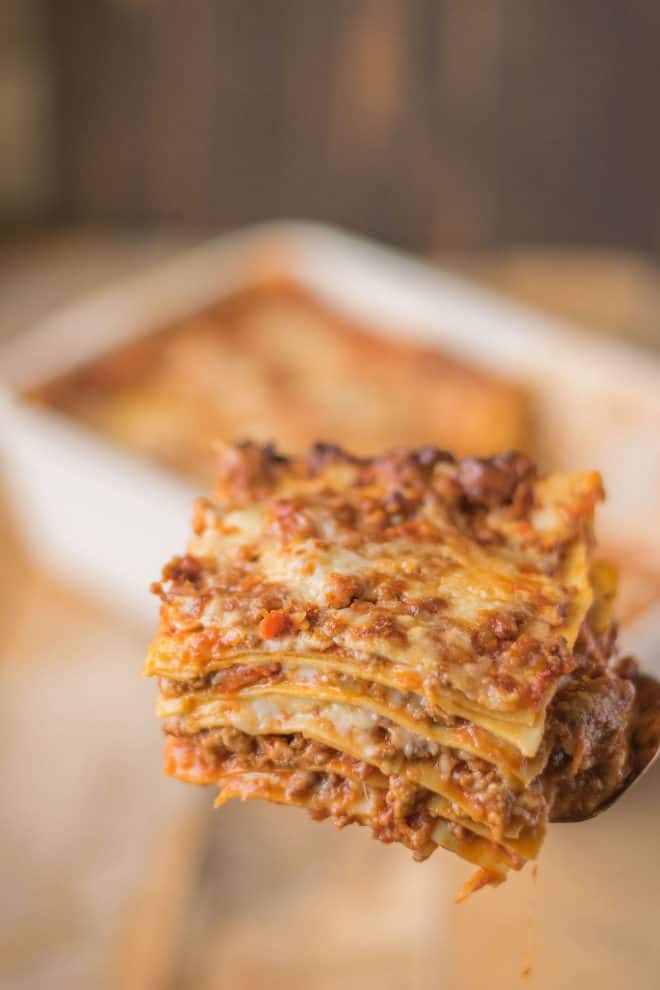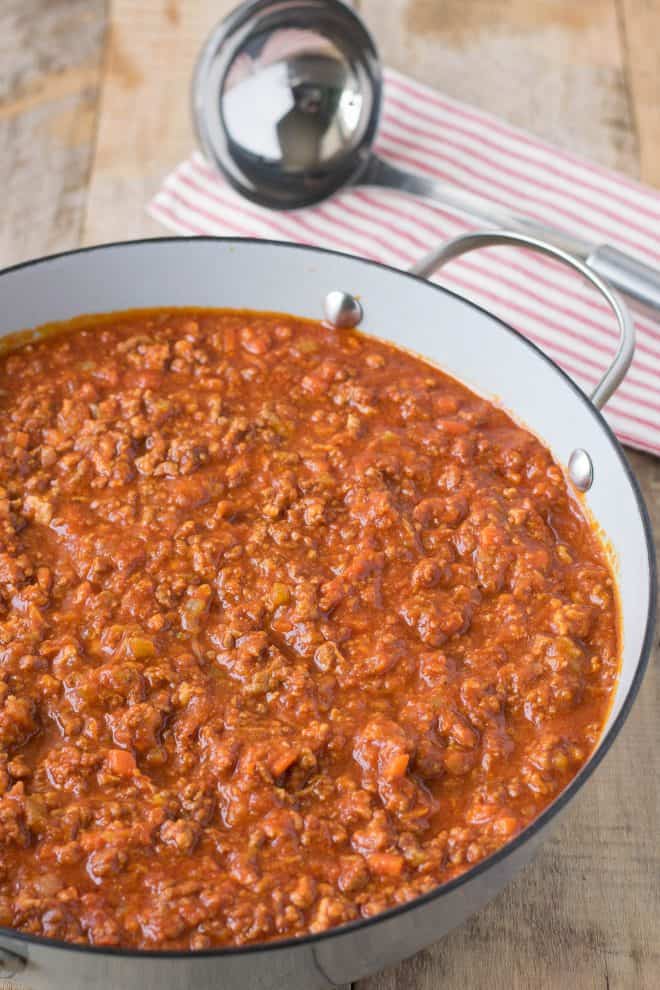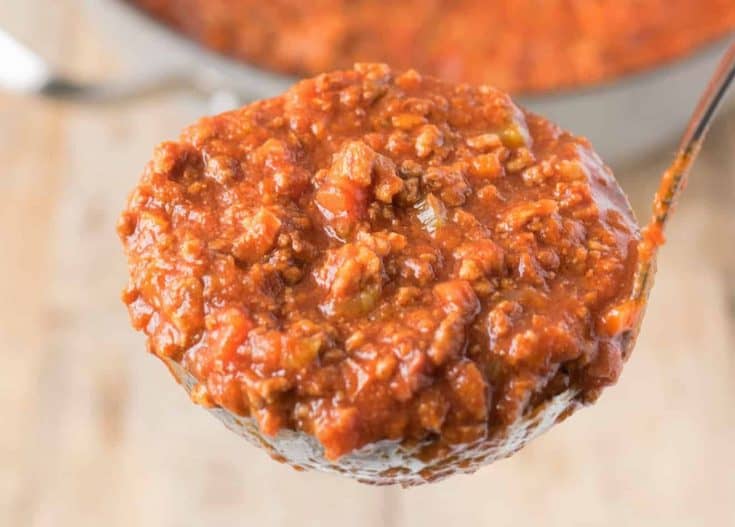I originally developed and published this recipe back in 2017. The recipe hasn’t changed, but I’ve added some valuable information to read, as well as a video. This sauce is cooked low and slow for 4 hours to develop a rich, hearty taste. My recipe makes a lot of sauce, and trust me, you’ll want more. Plus, it freezes really well. It’s the sauce that just keeps on giving.
Traditional Sauce from Bologna, Italy
Now, why do I say this is a traditional recipe? Because it has the same ingredients as the authentic Bolognese recipe from the home of Bolognese, the Chamber of Commerce, Industry, Craftsmanship, and Agriculture of Bologna, to be official.
Bolognese Sauce Ingredients
When you might expect oregano or basil in an Italian recipe, the seasonings in Bolognese are very minimal. Only salt and pepper are used. The other ingredients are ground beef, ground pork, onion, carrot, celery, wine, tomato purée/passata, milk, and beef broth.
THE BEST BOLOGNESE SAUCE IS COOKED LOW AND SLOW
A traditional Bolognese sauce is a rich, thick meat sauce that needs to cook for 4 hours. Yes, 4 hours! Trust me (I make this almost weekly), and you can read the comments to back this I’ve had people say (and I agree) that after 2 hours, it seems like it’s ready and it’s pretty good, 3 is even better, but 4 is best.
Milk in Bolognese Sauce
A few people have asked questions about adding the milk and how it seems weird. It’s not weird, as it serves a good purpose, plus, it’s how they do it in Italy. It helps to tenderize the meat, and after 4 hours, you won’t even notice it’s in there.
What are the best meats to use for Bolognese?
Usually 50% each of ground beef and pork is used with a really great flavor booster, pancetta (Italian unsmoked bacon). You can use all beef if you’re not a pork eater.
Tomato Sauce/Purée/Passata
The tomato base for this sauce are good, strained tomatoes from a jar or can that have no other ingredients that is a thick, liquid consistency. This product is called by a few different names around the world, purée, passata or sauce (not tomato ketchup which is also called tomato sauce in the U.K and Australia).
WHITE OR RED WINE IN BOLOGNESE
I like white wine, and and white is traditional, but you can use red if you prefer.
What can you make with this Bolognese?
This sauce is not only used in my Lasagna Bolognese, it can also be served with wide, flat tagliatelle, a pasta that can hold the weight of the sauce.
HOW MUCH SAUCE DOES THIS RECIPE MAKE?
This recipe yields 4 quarts/16 cups/3.7 liters of sauce. You will need a large pan for this and the reason I made so much is because this sauce is going in a lasagna Bolognese (which is also very large and really good!)
WHAT IS THE DIFFERENCE BETWEEN A RAGU AND BOLOGNESE?
Both are Italian meat sauces with slight differences, but they are both made with meat and it’s the choice of meats that make the difference in the sauces. Bolognese (Ragu all Bolognese) originates from Bologna, Italy. Simply named Ragu is from Naples Italy. They both use soffritto (carrots, celery, pancetta) beef broth and tomato sauce.
WHAT IS A MARINARA SAUCE?
Marinara is a tomato based sauce that has not meat. I have an easy recipe for this sauce here easy homemade marinara sauce.
How to Make Traditional Bolognese Sauce – Step by Step
Note: There is no garlic in Traditional Bolognese Sauce, but I have added it as an optional ingredient to the recipe for those asking for it.
Slow Cooker Bolognese Method
This is the perfect sauce to be cooked in the slow cooker. Prepare as the recipe instructs and after step 3, transfer the sauce to a slow cooker pre-heated on high and let it cook away for 4 hours. The sauce will become quite saucy with the lid on as it produces liquid, so remove the lid to help the sauce thicken.
Freezing Bolognese Sauce
I know that this recipe makes a lot of sauce, but it is so good I always make a full batch and freeze the rest because I end up craving it. To freeze any cooked leftovers, add the cooled sauce to a container with a good lid and seal well. You can keep it frozen for 3 months. To reheat, defrost in the fridge overnight and reheat in a pan.
How to Thicken Bolognese Sauce
This recipe thickens as it cooks for 4 hours. If you find that your sauce is not thickening after the 4 hour or is too thin (this could be the result of the meat or vegetables giving off liquid), remove the lid completely and turn up the heat so the sauce bubbles rapidly. This will allow the excess liquid to evaporate, but you MUST stir the sauce often to prevent it sticking to the bottom of the pan.
What to do if Bolognese Sauce is Too Thick
If the sauce is thickening too quickly as it simmers, turn the heat down and cover completely. If your leftovers are too thick (this can happen when the sauce is cold), add to a pan and reheat over medium heat, stirring. If the sauce is still too thick when it warms up, add a little beef stock, you can also add more tomato puree/passata. You want to reheat slowly to see how much liquid the sauce needs as it heats and add accordingly. Did you know there is a white Bolognese sauce?’ It’s true, but it’s not exactly white. The name just means it does not have any tomato product added. I recently added my own recipe here: Traditional White Bolognese Sauce. Garlic is not traditional, but I have had many requests as to how much to add so it is included in the recipe. Taste your stock, if it is salty, you may need to adjust the amount of salt in the dish
